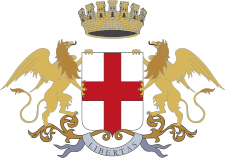Giovanni I di Murta
Giovanni di Murta (Murta, date unknown – Genoa, January 6, 1350) was elected the second doge of the Republic of Genoa after the resignation of Simone Boccanegra, on December 25, 1345.[1] His dogate was dominated by his attempts to break the circle of political violence which had crippled the city over the past century and to reassert the Genoese domination over the Mediterranean colonies.
Giovanni I di Murta | |
|---|---|
 | |
| 2nd Lifetime Doge of the Republic of Genoa | |
| In office December 25, 1345 – January 6, 1350 | |
| Preceded by | Simone Boccanegra |
| Succeeded by | Giovanni II Valente |
| Personal details | |
| Born | unknown date Murta, Republic of Genoa |
| Died | January 6, 1350 Genoa, Republic of Genoa |
| Political party | Popolani |
| Profession | Banker |
Early life
While his date of birth remains unknown, it is assumed that he was born in the early years of the 14th century in the village of Murta in the Val Polcevera, today one of the boroughs of the city of Genoa from an affluent commoner family, however his mother was from the powerful Usodimare patrician family.[2]
The Maona of Chios and Phocaea
He became a banker by trade. After his accession to the office of doge, he managed to somewhat pacify the city torn apart by the conflict between the various local aristocratic families. In particular, he managed to prevent the Grimaldi clan from seizing the city. Against them, Giovanni da Murta chartered a fleet of over two dozen privately owned armed galleys under the command of the admiral Simone Vignoso.
As the Grimaldis did not go out at sea to oppose the Republic's galleys,[1] the doge sent the navy to support the island of Chios, then a Genoese colony, which was besieged by Jani Beg, khan of the Golden Horde. The fleet also managed to reconquer the city of Phocea and its important alum mines on September 20, 1346.[1]
Upon his return, the admiral did not receive the very large amount of money initially promised to him as payment for his galleys. Consequently, the doge had to agree to entrust Simone Vignoso and a group of his associates with the governorship of Chios, granting them at the same time the fiscal revenues from the island for twenty years. This group of investors became known as the Maona of Chios and Phocaea.[3]
Mounting tension in the region
Giovanni da Murta also tried to regain control over the island of Corsica. At the beginning of his dogate only the citadel of Bonifacio remained in Genoese hands,[1] the rest of the colony was de facto independent thanks to the support of the kingdom of Aragon and of the Venetian fleet. The Doge entrusted his son, Tommaso, with mission of reconquering the island. This expedition marks the end of the feudal anarchy in Corsica and the beginning of a more asserted Genoese rule over the island.[4] To fund the military operations in the island, the Republic had to borrow at 20% from an association of creditors known as the Compera nuova acquisitionis Corsicæ on December 27, 1347.[5]
On the diplomatic front, Giovanni da Murta tried to appease the tension between Genoa and Venice, that followed the assault of the Genoese of Pera on Constantinople, perceived by the Venetians as a threat to their domination in the Levant. He proposed a joint crusade against the Ottomans, an offer which was dismissed by the Venetians.[6]
Plague and succession
The breakout of the Black Death occurred during his time in office. Republic was one of the first European cities hit by the pandemics as it was a Genoese ship sailing away from Kaffa, in the Crimea, besieged by the Mongols that carried the disease across the Mediterranean. From November 1347 to 1351, the plague killed 30 to 40% of the population of the city,[7] the Doge was among the victims. He died on January 6, 1350, and was buried in the Cathedral of San Lorenzo. His successor, Giovanni Valente, was elected three days later in a climate of tension between popolanis and aristocrats, making evident that his efforts to unite the city would be short-lived.
Unlike most of the other doges of the history of Genoa, Giovanni I di Murta left an excellent image of his time in office. He is hailed as a pacifier at home and abroad and he has even been qualified as a "lover of the common good" by a modern historian. [8]
References
- Epstein, Steven A. (1996). Genoa and the Genoese 958-1528. Chapel Hill: University of North Carolina Press. p. 209 et seg. ISBN 978-0-8078-4992-7.
- Gallo, Giuseppe (1997). La Repubblica di Genova tra nobili e popolari (1257-1528). De Ferrari. p. 191.
- Balard, Michel (1989). "The Genoese in the Aegean (1204-1566)". Mediterranean Historical Review. 4 (1): 158–174. doi:10.1080/09518968908569565.
- Angelini, Jean-Victor (1977). Histoire secrète de la Corse. Paris: Albin Michel. p. 117. ISBN 978-2-226-00461-1.
- Canale, Michele Giuseppe (1864). Nuova Istoria della repubblica di Genova. Epoca quarta (1339–1528): I dogi popolari. Florence: Felice Le Monnier. p. 151.
- Hazlitt, William Carew (1860). History of the Venetian Republic: her rise, her greatness and her civilization. London: Smith, Elder & Co. p. 105.
- Gottfried, Robert S. (1985). The black death: natural and human disaster in medieval Europe. New York: Simon and Schuster. p. 43. ISBN 978-0-02-912370-6.
- Ossian De Negri, Teofilo (2003). Storia di Genoa. Florence: Giunti Editore. p. 458. ISBN 978-88-09-02932-3.
